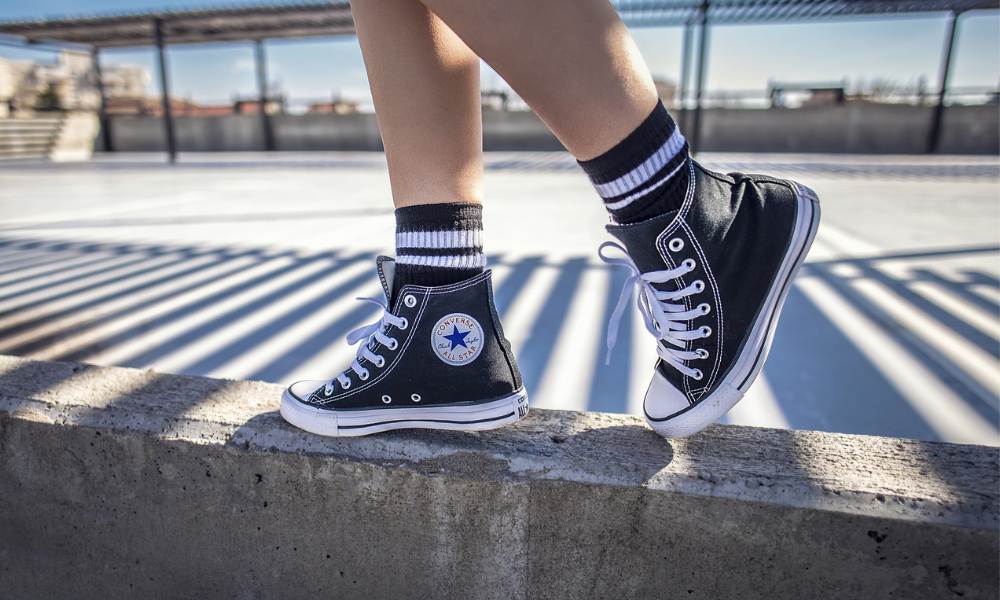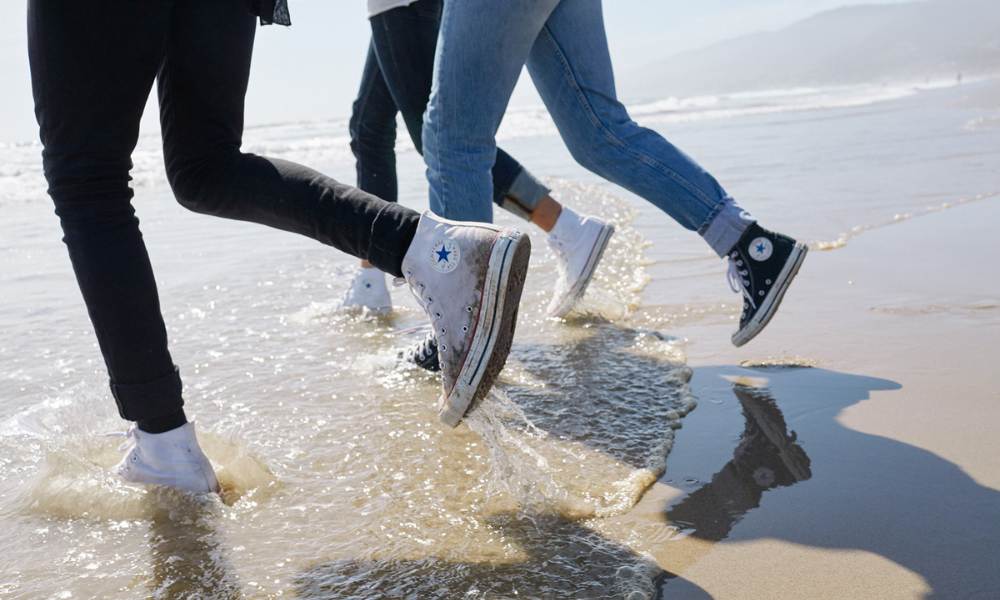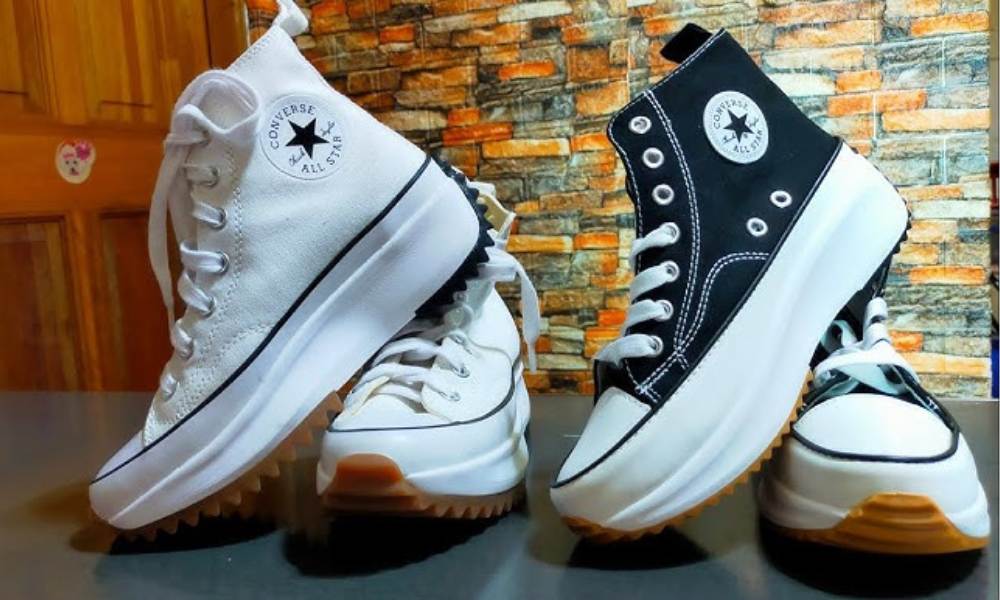
As an Amazon Associate I earn from qualifying purchases.
by ElenaStyle

As an Amazon Associate I earn from qualifying purchases.
Converse sneakers are undeniably stylish, blending seamlessly with a variety of fashion choices, and it’s easy to see why they might be your first pick for a hiking adventure.
Their light weight, affordability, and fashionable design make them a tempting choice. This might lead one to wonder: if they’re suitable for indoor exercise, could they also be a fit for outdoor activities like hiking?
Join us as we explore the intricacies of hiking footwear and why your beloved Converse sneakers, despite their appeal, might not be the best fit for the rugged demands of the trail.
Converse’s journey began in 1908 as a practical rubber shoe company. By 1917, they entered the basketball court with the All Star, later perfected by player Chuck Taylor in 1922. His signature became synonymous with the shoe, catapulting it to dominance in the 30s and 60s.
However, the 70s brought competition and hardship. But Converse was saved by unlikely heroes: punks, skaters, and alternative fashionistas. They embraced the Chuck Taylor’s rebellious spirit, transforming it from a courtside staple into a cultural icon.
Today, Converse thrives, blending its rich history with fresh designs and collaborations, keeping it a timeless favorite across generations and styles.
Also Read: How to Make Converse More Comfortable? (6 Tips)
Walking shoes should have several key features to provide both comfort and protection, catering to the needs of individuals engaged in walking activities. In contrast, running shoes are primarily engineered for athletes and other sports enthusiasts, offering a somewhat smoother feel for the feet.
Here are some important factors to consider when choosing walking shoes:
| Feature | Description |
|---|---|
| Cushioning | Paramount for absorbing shock and protecting joints, especially on hard surfaces. Shoes should have thick midsoles made of materials like gel, foam, or air. |
| Stability | Walking shoes should provide stable support to prevent feet from rolling inwards or outwards. Features like a firm heel counter and a wider base can help. |
| Breathability | Feet sweat, so it’s crucial to have shoes with breathable uppers made from materials like mesh or nylon. This prevents sweaty feet and blisters. |
| Fit | Walking shoes should fit snugly around your heel and midfoot with ample room (about a finger’s width) in the toe box for toe splay. This ensures comfort and proper foot function. |
| Traction | Good grip is essential for preventing slips and falls, especially on uneven terrain. Opt for shoes with outsoles made of durable rubber with deep treads for optimal traction. |

The main reason Converse shoes are not suitable for long walks is their lack of adequate cushioning and arch support. These shoes have thin, flat soles that offer minimal shock absorption, which can result in discomfort and fatigue when walking for extended periods.
For long walks, it’s generally recommended to opt for walking shoes specifically designed to provide the comfort, support, and durability needed to maintain foot health and comfort over extended distances.
If you’re planning on undertaking lengthy walks, it’s advisable to invest in a pair of dedicated walking or running shoes that offer the necessary features to support your feet during prolonged activity.
While Converse shoes are not typically recommended for hiking due to their limited support and cushioning, some individuals may still choose to wear them for certain hiking scenarios.
Here are a few potential advantages of wearing Converse shoes for hiking in specific situations:
Converse shoes are known for their lightweight design, which can be advantageous if you’re embarking on a short and easy hike on well-maintained trails. The reduced weight can help minimize fatigue during these less demanding outings.
Converse shoes come in various styles and colors, making them a versatile choice for those who prioritize style while hiking. If you’re going for a fashion-forward or retro look on a casual hike, Converse can fit the bill.
If you’re hiking in urban or city environments where the terrain is relatively flat and the paths are paved or well-groomed, Converse shoes can be suitable for short, leisurely walks and hikes.
Some hikers may have personally found Converse shoes to be comfortable for their specific foot shape and hiking style, although this varies from person to person.
Converse shoes may have some advantages in certain hiking situations, however they are not designed or recommended for more challenging or rugged hiking conditions. Your choice of footwear should align with the difficulty and terrain of your hiking adventure to reduce the risk of injury and discomfort.

Wearing Converse shoes for hiking is generally not recommended for several reasons:
Converse shoes, especially the classic Chuck Taylors, are designed for casual wear and not for the rigors of hiking. They lack the necessary ankle support that is crucial for navigating uneven and rough terrain, which can lead to increased risk of ankle sprains or injuries.
The soles of Converse shoes are flat and made for urban surfaces. They do not offer the same level of grip and traction that hiking boots or shoes provide, especially on slippery, wet, or uneven trails. This can lead to slips and falls.
Hiking trails often have sharp rocks, thorns, and other hazards. Converse shoes have thin soles and provide little protection from such elements, potentially leading to foot injuries.
Hiking can be hard on the feet, especially on longer trails. Converse shoes do not have the cushioning and shock absorption that is built into hiking footwear, which can result in discomfort and foot fatigue.
Converse shoes are not designed to withstand the elements like hiking shoes are. They offer little protection in wet conditions and are not suitable for trails that involve water crossings or muddy conditions.
While Converse shoes are stylish and comfortable for everyday use, they are not designed for the demands of hiking. For a safe and comfortable hiking experience, it’s best to invest in a pair of shoes specifically designed for the activity.
While it’s generally not recommended to hike in Converse shoes due to their lack of support, grip, and protection, if you find yourself in a situation where you have no other choice, here are some tips to help mitigate potential issues:
Also Read: How to Fix Converse Sides?
Making Converse shoes more comfortable for hiking involves addressing their key limitations: lack of support, cushioning, and grip.
Here are some strategies to enhance their comfort and suitability for light hiking:

Choosing the “best” Converse for hiking involves selecting a pair that offers the most support, comfort, and durability within the Converse range, while keeping in mind that they are not specifically designed for hiking.
Here are some Converse models that may be more suitable for light hiking:
The high-top design provides more ankle support than low tops, which can be beneficial for stability. The canvas upper is durable, but keep in mind it’s not waterproof or particularly breathable.
This model has a thicker canvas and a more cushioned insole compared to the classic Chuck Taylors. They also feature a slightly higher rubber sidewall and a more substantial toe cap, offering slightly better protection and durability.
Known for its suede construction, the One Star provides a bit more durability and resistance to wear compared to traditional canvas models. The sole also offers a bit more grip.
This is a more rugged version of the classic Chuck Taylor, designed with hiking boot elements. It offers better ankle support and a more durable construction. However, it’s still more fashion-oriented than functional for serious hiking.
Some Converse are designed with water-resistant or insulating materials. These can be a better choice for hiking in damp or cold conditions compared to the standard canvas models.
Some models come with Lunarlon cushioning, offering better foot support and comfort. This technology, initially developed by Nike, provides a softer, more responsive cushion.
While Converse sneakers hold a revered spot in the world of casual and fashion footwear, their suitability for walking, especially over extended periods or on challenging terrain, is limited. Their iconic design, though stylish and lightweight, lacks the essential features necessary for optimal walking support and comfort, such as adequate arch support, cushioning, and durable soles for varied surfaces.
Remember, while the style of your footwear is a personal expression, comfort and suitability for the activity at hand should always be a priority. Converse sneakers, with their rich history and cultural significance, will continue to be a beloved choice for many, but when it comes to walking, they might not be the one-size-fits-all solution.